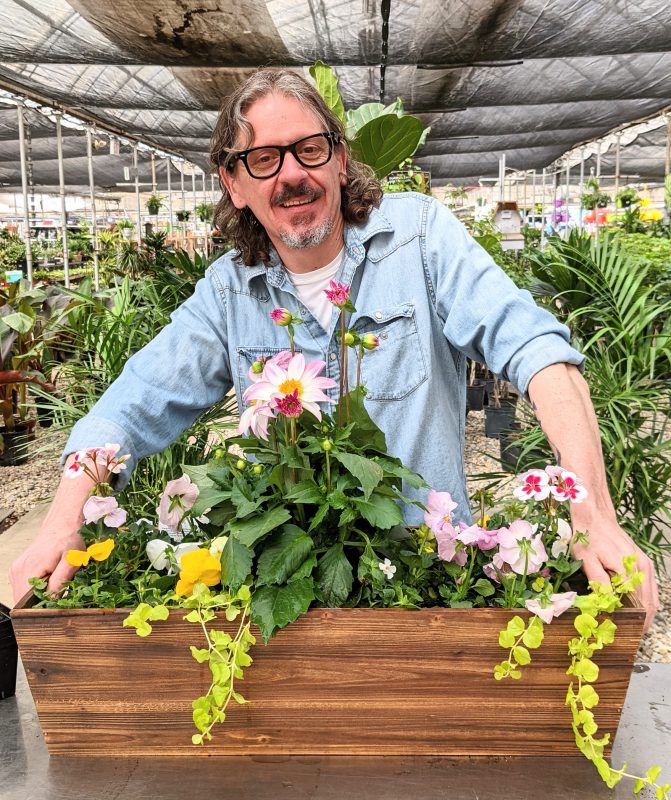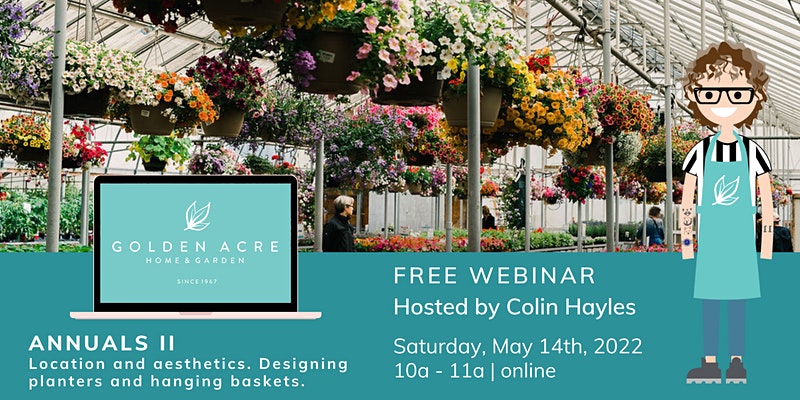One of the main things we love about gardening is how limitless our creativity can be. At the end of the day, this is our garden. We make it how we like it and that’s pretty neat. This week, we are focusing on annual planters. Gosh, over the years, we’ve seen some gorgeous planters not only in store, but also in the photos our customers have shared with us. From the curated blend of annual plants, to the very containers they sit in, planters and hanging baskets can be an extension of you. Planters are space fillers, statement pieces, and colour poppers that you can admire all season long. At Golden Acre, we handcraft our own annual planters. They are always a great source of inspiration should you need some.
So, let’s talk about ways to approach planning, planting, and maintaining annual planters.
PLANNING
Take some time to think about what your planters will look like and where they will live this summer.
- How do want them to look including colour and texture.
- Consider playing around with size in a planter by selecting:
- Thriller: The showstopper flower usually found in the middle/back of the planter.
- Filler: The middle plants that fill in the space between the thrillers and spillers.
- Spiller: The smallest plants that usually trail down the sides of the planter.
- Consider playing around with size in a planter by selecting:
- What purpose will they serve in your yard? Will they grow veggies, flowers, or both?
- What sun exposure does that area receive? What kind of weather will it be exposed to?
- Flowers
- Sun Loving: Marigolds, Petunias, Zinnia, Osteospermum, Portulaca, Million bells
- Shade loving: Begonia, Impatiens, Geranium, Bacopa, Creeping Jenny
- Veggies
- Sun Loving: Tomatoes, Strawberry, Cucumber, Peppers, Basil, Lavender
- Shade Loving: Kale, Lettuce, Spinach, Arugula, Chives, Dill.
- Flowers
- What kind of water will your plants need? Are they going to be growing veggies and need more water than flowers? Is you container wooden and need more water than a plastic pot?
- How will your planter be viewed? From below? Above? In a grouping? A planter against a wall may need to be designed differently than a round planter on a table that’ll be viewed from every direction.
- What size do you want it to be? Keep weight in mind when selecting a pot. Soil and plants
- What kind of maintenance is required, and do you have the ability to keep up with it over the course of the summer.
PLANTING
- CONTAINERS & POT | The best container to use will have drainage holes in the bottom to allow excess water to drain. We want to avoid root rot! If you wish to use a pot without drainage hole, fill the bottom two inches with gravel to water can drain into that reservoir.
- SOIL | A potting soil is best when planting planters. If have soil from last year, mix in some fresh stuff to bring in some new nutrients.
- PLAN | Plan where everything is going to go. Don’t be too worried about overcrowding, but there are spacing tips on each individual plant tag.
- PLANT | For step-by-step instruction for planting, view our encore video, or see our handy How-to guide located on our website.
- WATER & FERTILIZE | after you’re done planting. See below section for tips.
- Note: If you’re curious about starting seeds in planters as opposed to annual flowers, check out our Calgary & Area Seed Starting Chart
What Did Colin Plant today?
- Container:
- Wooden Window Box: Will require consistent checks on water as wood will naturally draw moisture from the soil.
- Soil:
- Pro mix Potting Mix: Works well for potted plants both in the garden and in the house.
- Annual Plants:
- Thrillers | 6″ Dahlia X1 & 4″ Regal Geraniums X 2
- Fillers | 2″ Pansies X 8
- Spillers | 2″ Creeping Jenny X 4 & 2″ Bacopa X 4
- Fertilizers:
- Promix Root Booster – Used right after you plant to help establish the root system.
- Promix Flower Boost – Used for the rest of the growing season. BEST RESULT

MAINTAINANCE
- Watering
- Check regularly by testing the moisture with your finger. If you can feel dry soil a couple inches down, it’s time to water. Sometimes you may need to water a few times a day especially in those hot summers!
- Not watering enough = poor production of fruits and flowers.
- Watering too much = breeding ground for pathogens and pests.
- Check regularly by testing the moisture with your finger. If you can feel dry soil a couple inches down, it’s time to water. Sometimes you may need to water a few times a day especially in those hot summers!
- Fertilizing
- Read and follow the label. Suuuuuper important. Over fertilizing will cause root burn and your plant will not survive.
- Fertilize consistently on a schedule and right up until the fall.
- Some of colin’s suggestions for fertilizers were:
- Promix Root Booster – Used right after you plant to help establish the root system.
- Promix Flower Boost – Used for the rest of the growing season. BEST RESULTS
- Promix Multi Purpose – Can also be used if you want something that’ll do it all!
- Deadheading
- Removal of “old” flowers to encourage the plant to put energy into new blooms. Doing this simple practice can give your plants a longer bloom period so you can enjoy them all season long. Pollinators will love you!
The more detailed encore presentation hosted by Colin Hayles is now available to view on our YouTube channel.
If you’d like a copy of Colin’s PowerPoint, click here: Golden Acre Webinars 2022 – Annuals – Planters
UPCOMING FREE WEBINARS/SEMINARS:
May 21, 2022: May Long Weekend Gardening Webinar – Ready, Set, Grow! <<< Register Now
May 28, 2022: Perennials II Webinar – Maintenance habits and Expectations <<< Register Now
Registration for all of our free Saturday Spring Webinars

